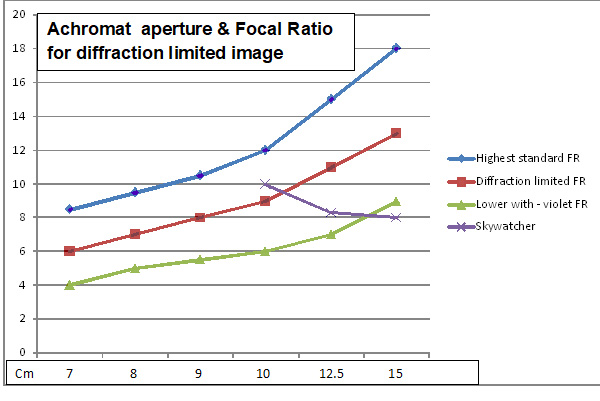› Forums › Telescopes › Bresser Telescopes › Bresser Telescopes
Late last year I bought a 120mm F1000 mm Skywatcher OTA and matched it to an EQ5 mount and added an RA drive. (I had always wanted a big refractor.) then, lo and behold, within months the local agent was selling 150mm 1200mm Celestron OTA.s for half price. I mated this with an old superseded Celestron DX mount which I got for 43% of the price that the same mount cost four years ago for my C14.
I managed to sell the 120mm for only a modest loss.
Now, my assessment.: Chromatic aberration is a problem with achromats. The way to largely avoid it is either have a focal ratio with a CA ratio greater than 3.0 or go to an ED glass version and pay more than twice the price. The CA ratio is determined by dividing in the focal ration by the aperture in inches. Thus for a 102mm (4 inches) to reach 3.0 it would have to be F12.
Okay, so I have had a 120mm at F8.3 and own a 150mm at F8. What have I found when using them?
Colour fringes resulted, bordered by a lovely pastel yellow green shade to the limbs of bright objects like the Moon and Jupiter not to forget a violet haze on these bright objects. The purists and ‘pretty picture’ imagers, of course, decamped to purchase ED glass versions, even triplet lenses, at costs starting several times greater for the equivalent sized optical tube assembly. A further factor for the 6” or 150mm (5.9”) refractors is that with the heavy objective, the tube becomes top heavy, so there is considerably more of it is below the point of balance than above. This means an extra high mount for comfortable viewing unless you propose to observe higher objects from a sitting or lying on the floor position. In my view the mount must be high enough to allow a minimum viewing height at vertical of (say) 80cm, namely around 10cm above standard table/desk height. It must also be sturdy enough to support the ~10kg weight and any mechanical issues resulting from a longer tube.
Okay, a 150mm F8 lens (which should be at least F18 by the formula), is an extreme example. A minus violet filter will clean up the image, taking a loss of light and in my case I have a yellow filter that does much the same thing and improves contrast but gives this a dirty yellow caste. What I am saying is to use these filters on bright objects when seeking contrast and removal of spurious blue/violet, but remove the filters when observing deep sky.
For many years I have had reflectors (up to 16″), then Schmidt Cassegrains (to 14″) and have added the large 150mm refractor. My assessment of the visual tightness of the star image (admiitedly possibly unconsciously influenced by ‘seeing’) is that if reflector images are a 6, then SCT’s are an 8.5, Maksutovs a 9, and refractors 9.5. (No optics are perfect.)
Then we are looking at the weight. In Skywatcher terms, a 100mm OTA will perhaps weigh 3kg, and be okay on an EQ3, a 120mm (5kg+) will need an EQ5 (not much heavier mount), but a 150mm is around 10kg and needs much more.
I sold my 120mm to an older fellow and the whole setup probably was not more than about 15 to 16kg.
Now, though refractors look nice and classical and are wonderful conversation pieces standing in the corner of the lounge room, they are awkward and bulky, particularly to negotiate up stairs. How about a nice short SCT or Maksutov, which is much more convenient to use?
